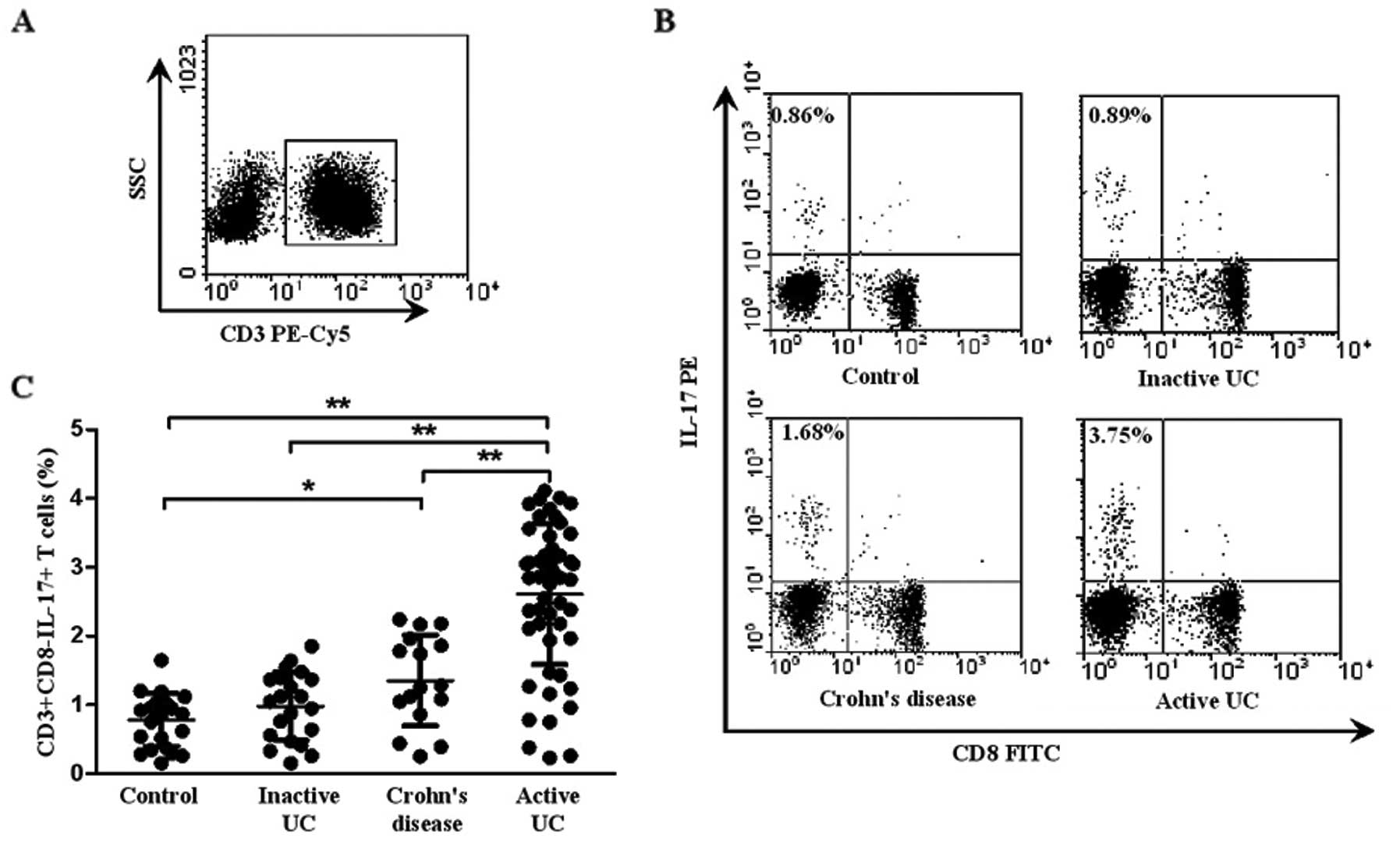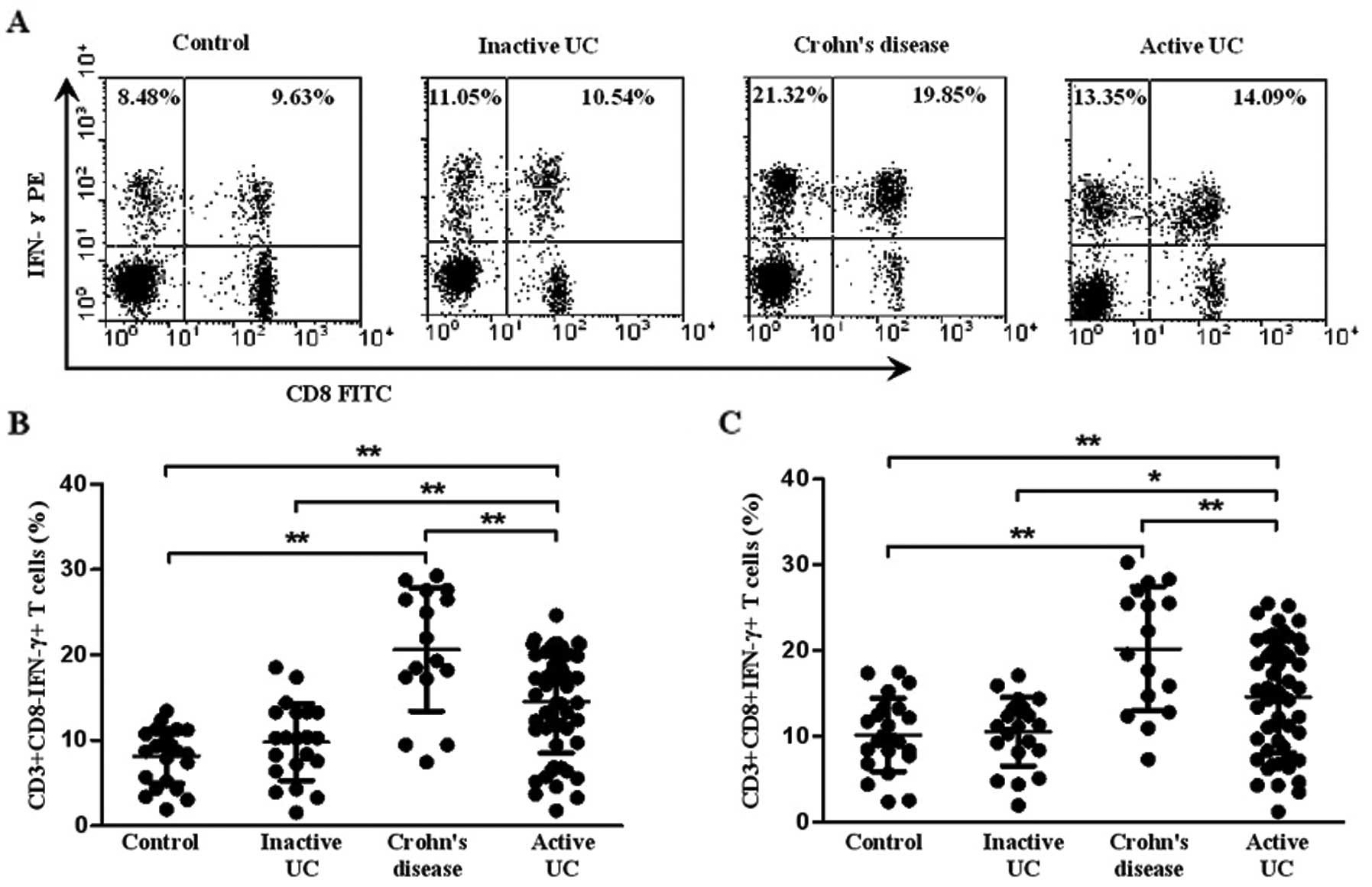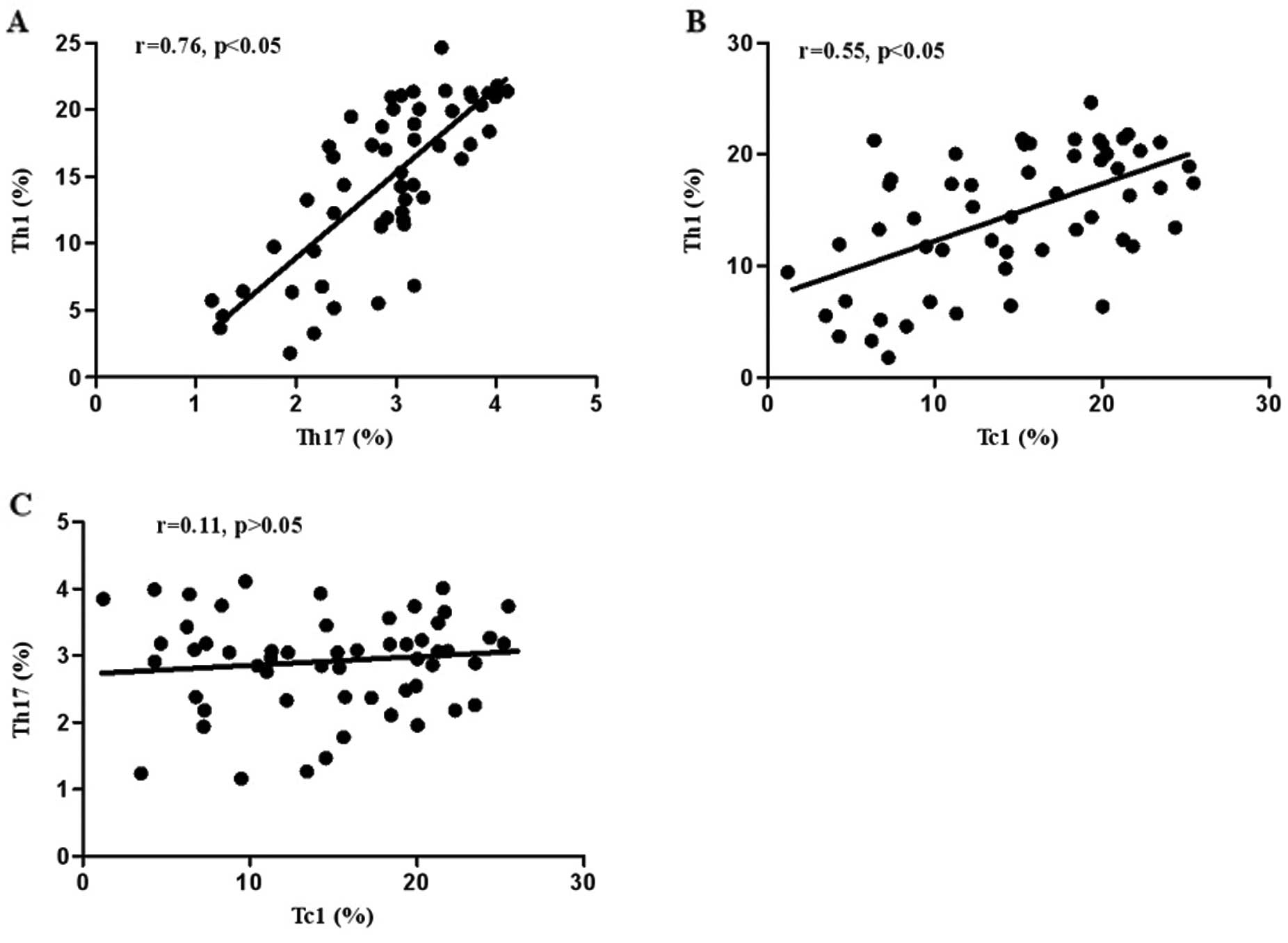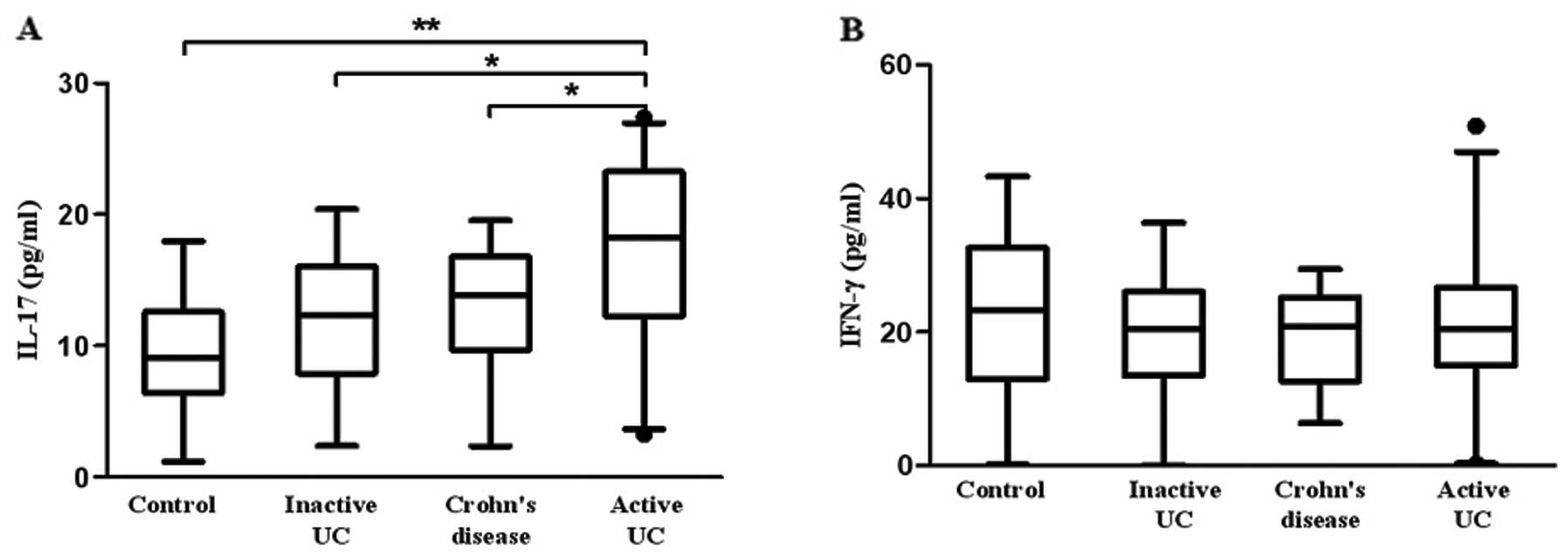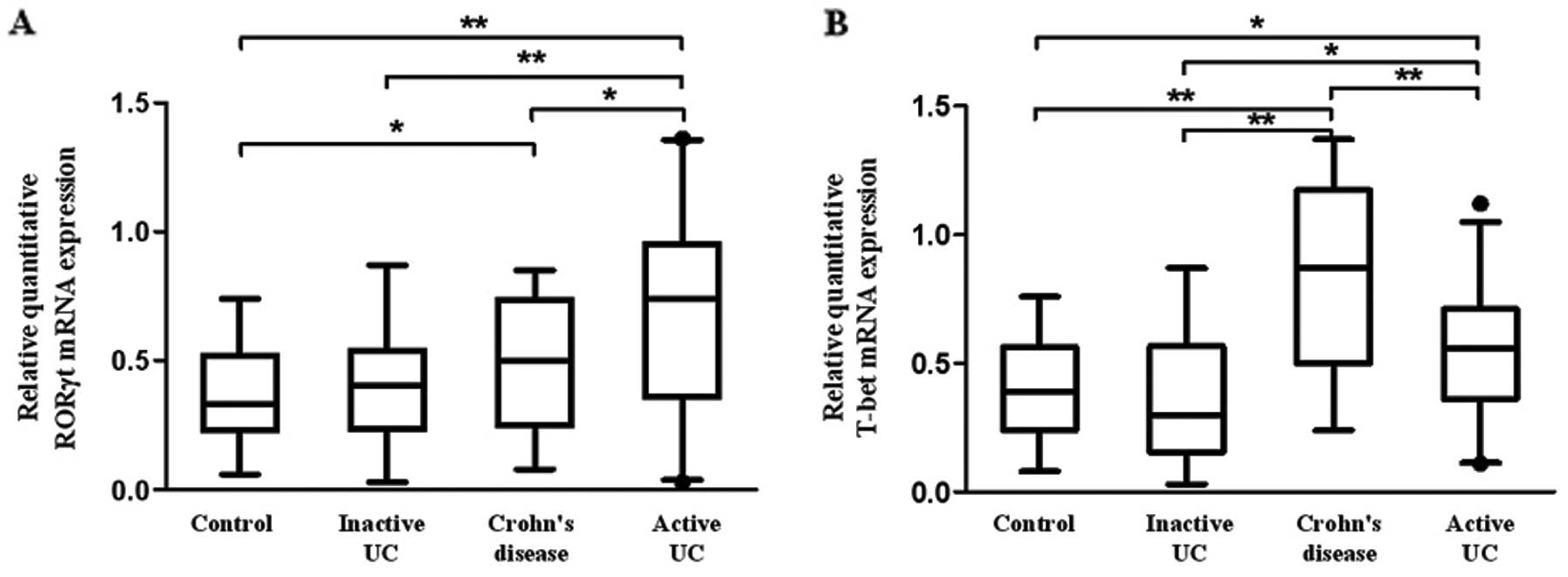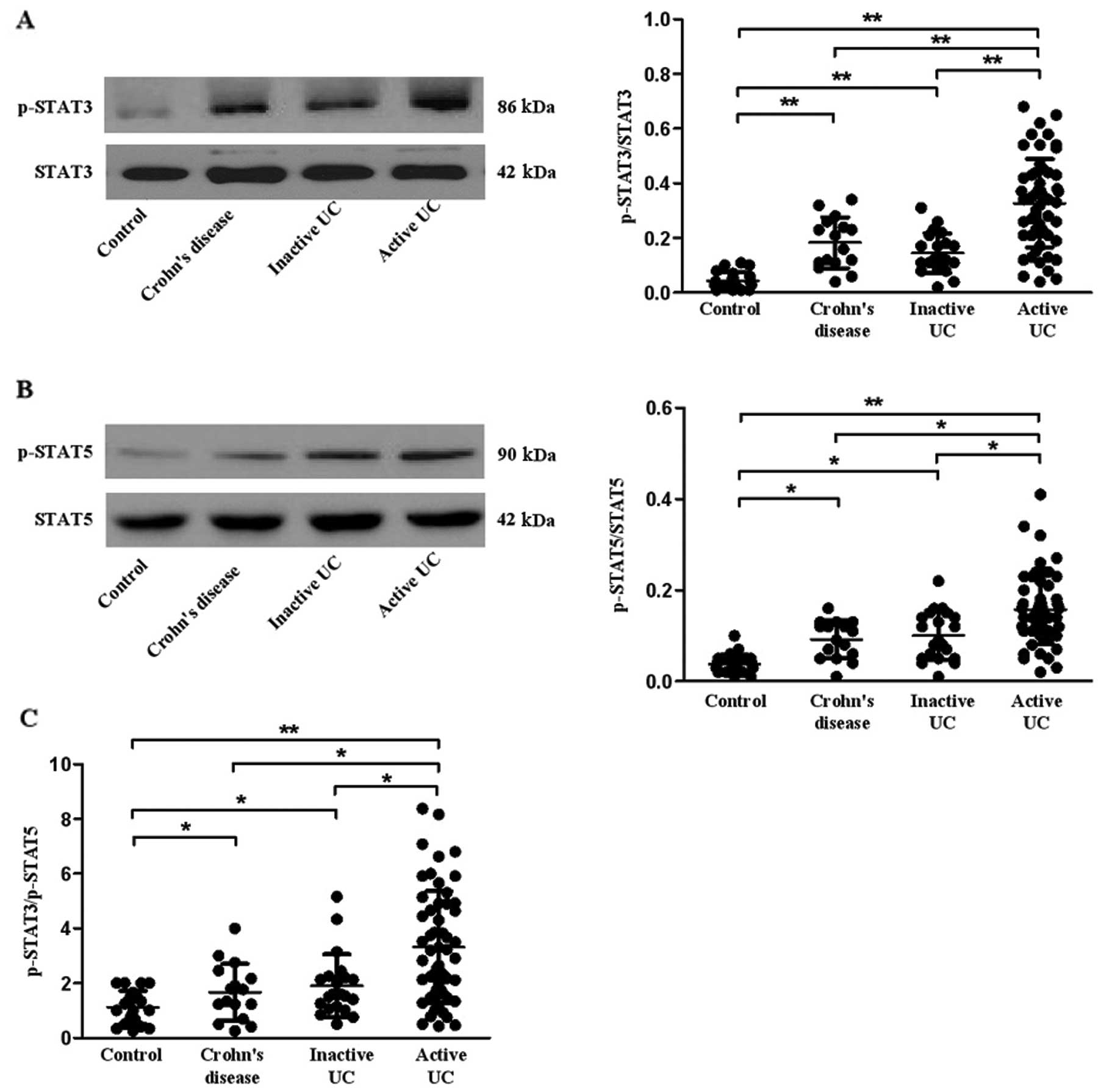|
1
|
Wang YF, Ouyang Q and Hu RW: Progression
of inflammatory bowel disease in China. J Dig Dis. 11:76–82. 2010.
View Article : Google Scholar : PubMed/NCBI
|
|
2
|
Eaden JA, Abrams KR and Mayberry JF: The
risk of colorectal cancer in ulcerative colitis: a meta-analysis.
Gut. 48:526–535. 2001. View Article : Google Scholar : PubMed/NCBI
|
|
3
|
Choi PM and Zelig MP: Similarity of
colorectal cancer in Crohn’s disease and ulcerative colitis:
implications for carcinogenesis and prevention. Gut. 35:950–954.
1994.
|
|
4
|
Targan SR and Karp LC: Defects in mucosal
immunity leading to ulcerative colitis. Immunol Rev. 206:296–305.
2005. View Article : Google Scholar : PubMed/NCBI
|
|
5
|
Ishiguro Y: Mucosal proinflammatory
cytokine production correlates with endoscopic activity of
ulcerative colitis. J Gastroenterol. 34:66–74. 1999. View Article : Google Scholar : PubMed/NCBI
|
|
6
|
Strober W and Fuss IJ: Proinflammatory
cytokines in the pathogenesis of inflammatory bowel diseases.
Gastroenterology. 140:1756–1767. 2011. View Article : Google Scholar : PubMed/NCBI
|
|
7
|
Melgar S, Yeung MM, Bas A, et al:
Over-expression of interleukin 10 in mucosal T cells of patients
with active ulcerative colitis. Clin Exp Immunol. 134:127–137.
2003. View Article : Google Scholar : PubMed/NCBI
|
|
8
|
Strober W, Fuss IJ and Blumberg RS: The
immunology of mucosal models of inflammation. Annu Rev Immunol.
20:495–549. 2002. View Article : Google Scholar : PubMed/NCBI
|
|
9
|
Rismo R, Olsen T, Cui G, Christiansen I,
Florholmen J and Goll R: Mucosal cytokine gene expression profiles
as biomarkers of response to infliximab in ulcerative colitis.
Scand J Gastroenterol. 47:538–547. 2012. View Article : Google Scholar : PubMed/NCBI
|
|
10
|
Komatsu M, Kobayashi D, Saito K, et al:
Tumor necrosis factor-alpha in serum of patients with inflammatory
bowel disease as measured by a highly sensitive immuno-PCR. Clin
Chem. 47:1297–1301. 2001.PubMed/NCBI
|
|
11
|
Akazawa A, Sakaida I, Higaki S, Kubo Y,
Uchida K and Okita K: Increased expression of tumor necrosis
factor-alpha messenger RNA in the intestinal mucosa of inflammatory
bowel disease, particularly in patients with disease in the
inactive phase. J Gastroenterol. 37:345–353. 2002. View Article : Google Scholar
|
|
12
|
Olsen T, Goll R, Cui G, et al: Tissue
levels of tumor necrosis factor-alpha correlates with grade of
inflammation in untreated ulcerative colitis. Scand J
Gastroenterol. 42:1312–1320. 2007. View Article : Google Scholar : PubMed/NCBI
|
|
13
|
Bernardo D, Vallejo-Díez S, Mann ER, et
al: IL-6 promotes immune responses in human ulcerative colitis and
induces a skin-homing phenotype in the dendritic cells and T cells
they stimulate. Eur J Immunol. 42:1337–1353. 2012. View Article : Google Scholar : PubMed/NCBI
|
|
14
|
Rovedatti L, Kudo T, Biancheri P, et al:
Differential regulation of interleukin 17 and interferon gamma
production in inflammatory bowel disease. Gut. 58:1629–1636. 2009.
View Article : Google Scholar : PubMed/NCBI
|
|
15
|
Zhang J, Ma D, Zhu X, Qu X, Ji C and Hou
M: Elevated profile of Th17, Th1 and Tc1 cells in patients with
immune thrombocytopenic purpura. Haematologica. 94:1326–1329. 2009.
View Article : Google Scholar : PubMed/NCBI
|
|
16
|
Zhang L, Li JM, Liu XG, et al: Elevated
Th22 cells correlated with Th17 cells in patients with rheumatoid
arthritis. J Clin Immunol. 31:606–614. 2011. View Article : Google Scholar : PubMed/NCBI
|
|
17
|
Harrington LE, Hatton RD, Mangan PR, et
al: Interleukin 17-producing CD4+ effector T cells
develop via a lineage distinct from the T helper type 1 and 2
lineages. Nat Immunol. 6:1123–1132. 2005.PubMed/NCBI
|
|
18
|
Park H, Li Z, Yang XO, et al: A distinct
lineage of CD4 T cells regulates tissue inflammation by producing
interleukin 17. Nat Immunol. 6:1133–1141. 2005. View Article : Google Scholar : PubMed/NCBI
|
|
19
|
Monteleone I, Pallone F and Monteleone G:
Th17-cytokine blockers as a new approach for treating inflammatory
bowel disease. Ann Med. 43:172–178. 2011. View Article : Google Scholar : PubMed/NCBI
|
|
20
|
Bettelli E, Korn T, Oukka M and Kuchroo
VK: Induction and effector functions of T(H)17 cells. Nature.
453:1051–1057. 2008. View Article : Google Scholar : PubMed/NCBI
|
|
21
|
Ivanov II, McKenzie BS, Zhou L, et al: The
orphan nuclear receptor RORgammat directs the differentiation
program of proinflammatory IL-17+ T helper cells. Cell.
126:1121–1133. 2006. View Article : Google Scholar : PubMed/NCBI
|
|
22
|
Li Y, de Haar C, Chen M, et al:
Disease-related expression of the IL6/STAT3/SOCS3 signalling
pathway in ulcerative colitis and ulcerative colitis-related
carcinogenesis. Gut. 59:227–235. 2010. View Article : Google Scholar : PubMed/NCBI
|
|
23
|
Bi Y and Yang R: Direct and indirect
regulatory mechanisms in TH17 cell differentiation and functions.
Scand J Immunol. 75:543–552. 2012. View Article : Google Scholar : PubMed/NCBI
|
|
24
|
Monteleone I, Pallone F and Monteleone G:
Th17-related cytokines: new players in the control of chronic
intestinal inflammation. BMC Med. 9:1222011. View Article : Google Scholar : PubMed/NCBI
|
|
25
|
Li F, Zou Y and Li X: Up-regulation of
signal transducer and activator of transcription-3 is associated
with aggravation of ulcerative colitis. Surgeon. 8:262–266. 2010.
View Article : Google Scholar : PubMed/NCBI
|
|
26
|
Sandborn WJ and Faubion WA: Biologics in
inflammatory bowel disease: how much progress have we made? Gut.
53:1366–1373. 2004. View Article : Google Scholar : PubMed/NCBI
|
|
27
|
Sands BE: From symptom to diagnosis:
clinical distinctions among various forms of intestinal
inflammation. Gastroenterology. 126:1518–1532. 2004. View Article : Google Scholar : PubMed/NCBI
|
|
28
|
Schroeder KW, Tremaine WJ and Ilstrup DM:
Coated oral 5-aminosalicylic acid therapy for mildly to moderately
active ulcerative colitis. A randomized study. N Engl J Med.
317:1625–1629. 1987. View Article : Google Scholar : PubMed/NCBI
|
|
29
|
Hart AL, Kamm MA, Knight SC and Stagg AJ:
Prospective evaluation of intestinal homing memory T cells in
ulcerative colitis. Inflamm Bowel Dis. 10:496–503. 2004. View Article : Google Scholar : PubMed/NCBI
|
|
30
|
Bitton A, Peppercorn MA, Antonioli DA, et
al: Clinical, biological, and histologic parameters as predictors
of relapse in ulcerative colitis. Gastroenterology. 120:13–20.
2001. View Article : Google Scholar : PubMed/NCBI
|
|
31
|
Ge J, Wang K, Meng QH, Qi ZX, Meng FL and
Fan YC: Implication of Th17 and Th1 cells in patients with chronic
active hepatitis B. J Clin Immunol. 30:60–67. 2010. View Article : Google Scholar : PubMed/NCBI
|
|
32
|
Pelchen-Matthews A, Parsons IJ and Marsh
M: Phorbol ester-induced downregulation of CD4 is a multistep
process involving dissociation from p56lck, increased association
with clathrin-coated pits, and altered endosomal sorting. J Exp
Med. 178:1209–1222. 1993. View Article : Google Scholar
|
|
33
|
Yang XP, Ghoreschi K, Steward-Tharp SM, et
al: Opposing regulation of the locus encoding IL-17 through direct,
reciprocal actions of STAT3 and STAT5. Nat Immunol. 12:247–254.
2011. View Article : Google Scholar : PubMed/NCBI
|
|
34
|
Laurence A, Tato CM, Davidson TS, et al:
Interleukin-2 signaling via STAT5 constrains T helper 17 cell
generation. Immunity. 26:371–381. 2007. View Article : Google Scholar : PubMed/NCBI
|
|
35
|
Kolls JK and Lindén A: Interleukin-17
family members and inflammation. Immunity. 21:467–476. 2004.
View Article : Google Scholar : PubMed/NCBI
|
|
36
|
Ohta N, Makihara S, Okano M, et al: Roles
of IL-17, Th1, and Tc1 cells in patients with IgG4-related
sclerosing sialadenitis. Laryngoscope. 122:2169–2174. 2012.
View Article : Google Scholar : PubMed/NCBI
|
|
37
|
Olsen T, Rismo R, Cui G, Goll R,
Christiansen I and Florholmen J: TH1 and TH17 interactions in
untreated inflamed mucosa of inflammatory bowel disease, and their
potential to mediate the inflammation. Cytokine. 56:633–640. 2011.
View Article : Google Scholar : PubMed/NCBI
|
|
38
|
Turner D, Mack DR, Hyams J, et al:
C-reactive protein (CRP), erythrocyte sedimentation rate (ESR) or
both? A systematic evaluation in pediatric ulcerative colitis. J
Crohns Colitis. 5:423–429. 2011. View Article : Google Scholar : PubMed/NCBI
|
|
39
|
Dong C: TH17 cells in development: an
updated view of their molecular identity and genetic programming.
Nat Rev Immunol. 8:337–348. 2008. View Article : Google Scholar : PubMed/NCBI
|
|
40
|
Leppkes M, Becker C, Ivanov II, et al:
RORgamma-expressing Th17 cells induce murine chronic intestinal
inflammation via redundant effects of IL-17A and IL-17F.
Gastroenterology. 136:257–267. 2009. View Article : Google Scholar : PubMed/NCBI
|
|
41
|
Boniface K, Blumenschein WM, Brovont-Porth
K, et al: Human Th17 cells comprise heterogeneous subsets including
IFN-γ-producing cells with distinct properties from the Th1
lineage. J Immunol. 185:679–687. 2010.PubMed/NCBI
|
|
42
|
Garg SK, Voelmle MK, Beatson CR, et al:
Use of continuous glucose monitoring in subjects with type 1
diabetes on multiple daily injections versus continuous
subcutaneous insulin infusion therapy: a prospective 6-month study.
Diabetes Care. 34:574–579. 2011. View Article : Google Scholar
|
|
43
|
Johnston RJ, Choi YS, Diamond JA, Yang JA
and Crotty S: STAT5 is a potent negative regulator of TFH cell
differentiation. J Exp Med. 209:243–250. 2012. View Article : Google Scholar : PubMed/NCBI
|
|
44
|
Fujino S, Andoh A, Bamba S, et al:
Increased expression of interleukin 17 in inflammatory bowel
disease. Gut. 52:65–70. 2003. View Article : Google Scholar : PubMed/NCBI
|
|
45
|
Bisping G, Lugering N, Lutke-Brintrup S,
et al: Patients with inflammatory bowel disease (IBD) reveal
increased induction capacity of intracellular interferon-gamma
(IFN-gamma) in peripheral CD8+ lymphocytes co-cultured
with intestinal epithelial cells. Clin Exp Immunol. 123:15–22.
2001. View Article : Google Scholar : PubMed/NCBI
|
|
46
|
Kamikozuru K, Fukunaga K, Hirota S, et al:
The expression profile of functional regulatory T cells,
CD4+CD25high+/forkhead box protein
P3+, in patients with ulcerative colitis during active
and quiescent disease. Clin Exp Immunol. 156:320–327.
2009.PubMed/NCBI
|



